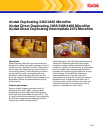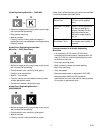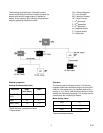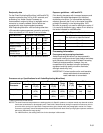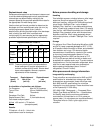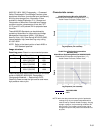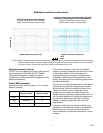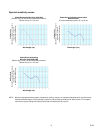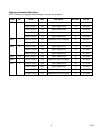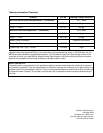
6D-32
ANSI ISO 18911 2000, Photography — Processed
Safety Photographic Films-Storage Practices, gives
appropriate conditions for extended term (permanent)
and long-term storage films. Information is also
available in Kodak Publication D-31, Storage and
Preservation of Microfilms. Extended term storage
conditions require a temperature of less that 70°F
(21°C) and 20- to 50-percent RH for polyester base
microfilm.
These ANSI/ISO Standards can be obtained by
contacting: Association for Information and Image
Management International (AIIM), 1100 Wayne
Avenue, Suite 1100, Silver Spring, MD 20910-5603,
Internet website: http://www.ansi.org or by calling
301-587-8202.
NOTE: Refer to the latest revision of each ANSI or
ISO Standard specified.
Image structure
Resolving power: Based on recommended process.
These values were determined according to a method
similar to ANSI/ISO 6328-2000, Photography —
Photographic Materials — Determining of ISO
Resolving Power, except the light source used was a
high-pressure mercury arc.
Characteristic curves
NOTE: While the data presented are typical of production
coatings, they do not represent standards which
must be met by Eastman Kodak Company. Varying
storage, exposure, and processing conditions will
affect results. The company reserves the right to
change and improve the product characteristics at
any time.
Film Test-Object Contrast Lines/mm
x462 1.6:1 (ISO-RPL)
1000:1 (ISO-RP)
250
630
x468 1.6:1 (ISO-RPL)
1000:1 (ISO-RP)
400
1000
2470 1.6:1 (ISO-RPL)
1000:1 (ISO-RP)
400
1000
Kodak Duplicating Microfilm 2462/4462
Kodak Microfilm Developer and Replenisher (1:7),
Kodak Prostar Processor, Diffuse Visual
Density
Log Exposure (lux seconds)
Kodak Direct Duplicating Intermediate
Microfilm 2470
Kodak Direct Duplicating Microfilm 2468/3468/4468
Kodak Microfilm Developer and Replenisher (1:7),
Kodak Prostar Processor, Diffuse Visual
Density
Log Exposure (lux seconds)
2468/3468/4468
2470



